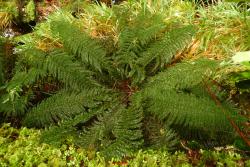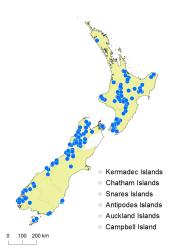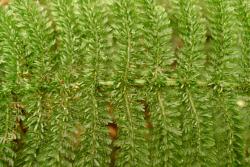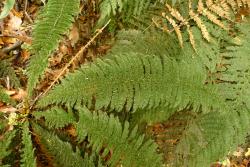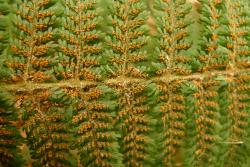- ≡ Todea superba Colenso, Tasmanian J. Nat. Sci. 2: 188 (1845)
- ≡ Osmunda superba (Colenso) J.B.Armstr., Trans. & Proc. New Zealand Inst. 13: 368 (1881)
Rhizomes erect, short or sometimes forming woody trunks up to 1000 mm tall. Fronds 250–1000 mm long. Stipes 15–190 mm long, pale brown, woolly hairy. Laminae 2-pinnate-pinnatifid, elliptic, 160–980 mm long, 60–250 mm wide, dark green, membranous and translucent, densely woolly hairy especially on costae of primary and secondary pinnae. Primary pinnae in 30–60 pairs, narrowly ovate to linear, with acute apices, crowded along rachis; the longest at or about the middle of the rachis, 30–130 mm long, 6–23 mm wide; the basal pair 1–20 mm long. Secondary pinnae oblong or narrowly elliptic, 6–11 mm long, 3–5 mm wide, sessile, divided most of the way to the midrib. Ultimate laminal segments linear, obtuse, bent upwards at 90° to plane of frond. Sporangia scattered on abaxial surfaces, confined to proximal part of primary and secondary pinnae.
Leptopteris superba has very thin, membranous fronds, resembling filmy ferns, and can be confused with them when very young. It is distinguished from L. hymenophylloides by its shorter stipe, lamina that tapers to both ends, shorter and narrower pinnae, and by its ultimate laminal segments that are bent upwards away from the lamina surface like the pile of a carpet. The basal pinnae (1–20 mm long) are significantly shorter than those in L. hymenophylloides (50–120 mm long) and this character alone will usually distinguish the two species.
North Island: Northland, Auckland, Volcanic Plateau, Gisborne, Taranaki, Southern North Island.
South Island: Western Nelson, Sounds-Nelson, Westland, Canterbury, Otago, Southland, Fiordland.
Stewart Island.
Altitudinal range: 0–1600 m.
Leptopteris superba has a predominantly southern distribution, occurring from Mt Te Aroha southwards, apart from an isolated record (Rawlings 1972) from c. 700 m in Waipoua Forest (CHR 191223) and a 19th century collection by E.M. Smith from Little Barrier Island (AK 119092). In the North Island it is common in montane forest from Te Aroha to Wellington, occurring from about 250 m up to 1400 m on Maungapōhatu in the Urewera Ranges. In the South Island it is abundant in wet forest on the west side of the Main Divide, in the Marlborough Sounds, and around Dunedin and the Catlins, extending also to Stewart Island. It occurs from sea level in Fiordland to about 1600 m in the Takitimu Ranges near Monowai.
A terrestrial fern that occurs in lowland to montane forest, growing best in cool, shaded forest in wetter sites and valley floors, sometimes in boggy ground. It requires constant high humidity, and cannot tolerate high temperature or light intensity. It is found primarily in beech, podocarp or kāmahi forest, extending locally into subalpine scrub.
Leptopteris superba and L. hymenophylloides frequently occur together in wet, forested areas, and they hybridise readily. Hybrids (Leptopteris ×intermedia) show regular bivalent formation at meiosis and have spores of normal appearance, but there is no evidence for second-generation hybrids (Brownsey 1981).
n = 22 (Manton 1950; Brownlie 1958; Brownsey 1981).



